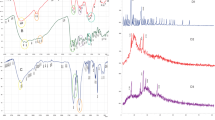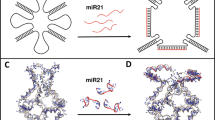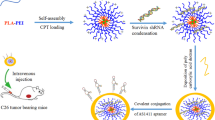Abstract
Manipulation of tumor microRNAs (miRNAs) may offer novel avenues for treatment of cancer. However, development of safe, robust, non-viral delivery methods remains a main challenge to obtain the promise of gene therapy. The miR-145 is dysregulated in many cancers, including colon carcer, and further in vitro investigation established antiproliferative and proapoptotic roles of miR-145. Herein, we study a PLGA/PEI (poly (d, l-lactide-co-glycolide)/polyethylenimine)-mediated miRNA vector delivery system; the validation of the method was carried out using a colon cancer xenograft model with miR-145 vector encoding for the expression of miR-145 (pDNA). First, high-molecular-weight PEI (25000 Da) was conjugated with cetyl to formulate reducible cetylated PEI (PEI-cet), and then PEI-cet was introduced to PLGA suspension. Next, PLGA/PEI-cet was crosslinked with hyaluronic acid (HA) to facilitate cellular uptake of miRNA plasmid vector via HA receptor-mediated endocytosis. After local administration of PLGA/PEI/HA complexes, intact miRNA plasmid vectors were delivered into HCT-116 colon cancer cells and xenograft tumor-bearing mice, and significant antitumor effects were achieved. The results show that the HA-based miR-145 nanocarrier could efficiently facilitate cellular uptake and significantly enhance miR-145 expression in HCT-116 cells. Consequently, the increased miR-145 induced G1 cell cycle arrest, reduced tumor proliferation and increased apoptosis, inhibited HCT-116 cell migration and suppressed c-MYC expressions, a regulatory target of miR-145. Of particular importance is the significant decrease in tumor growth in the mice model of colon cancer with the targeting miR-145 delivery system. The results in this work show that miR-145 has been effectively delivered to colon carcinomas through a PLGA/PEI/HA vehicle, indicating a promising miRNA replacement therapy strategy.
This is a preview of subscription content, access via your institution
Access options
Subscribe to this journal
Receive 12 print issues and online access
$259.00 per year
only $21.58 per issue
Buy this article
- Purchase on Springer Link
- Instant access to full article PDF
Prices may be subject to local taxes which are calculated during checkout






Similar content being viewed by others
References
Farh KKH, Grimson A, Jan C, Lewis BP, Johnston WK, Lim LP et al. The widespread impact of mammalian microRNAs on mRNA repression and evolution. Science 2005; 310: 1817–1821.
Mulrane L, McGee SF, Gallagher WM, O'Connor DP . miRNA dysregulation in breast cancer. Cancer Res 2013; 73: 6554–6562.
Lee H, Choi HJ, Kang CS, Lee HJ, Lee WS, Park CS . Expression of miRNAs and PTEN in endometrial specimens ranging from histologically normal to hyperplasia and endometrial adenocarcinoma. Mod Pathol 2012; 25: 1508–1515.
Liang G, Li J, Sun B, Li S, Lu L, Wang Y et al. Deep sequencing reveals complex mechanisms of microRNA deregulation in colorectal cancer. Int J Oncol 2014; 45: 603–610.
Kaur S, Lotsari JE, Al-Sohaily S, Warusavitarne J, Kohonen-Corish MRJ, Peltomaki P . Identification of subgroup-specific miRNA patterns by epigenetic profiling of sporadic and Lynch syndrome-associated colorectal and endometrial carcinoma. Clin Epigenet 2015; 7: 20.
Kasinski AL, Kelnar K, Stahlhut C, Orellana E, Zhao J, Shimer E et al. A combinatorial microRNA therapeutics approach to suppressing non-small cell lung cancer. Oncogene 2015; 34: 3547–3555.
Ibrahim AF, Weirauch U, Thomas M, Gruenweller A, Hartmann RK, Aigner A . MicroRNA replacement therapy for miR-145 and miR-33a is efficacious in a model of colon carcinoma. Cancer Res 2011; 71: 5214–5224.
Pagliuca A, Valvo C, Fabrizi E, di Martino S, Biffoni M, Runci D et al. Analysis of the combined action of miR-143 and miR-145 on oncogenic pathways in colorectal cancer cells reveals a coordinate program of gene repression. Oncogene 2013; 32: 4806–4813.
Yu C-C, Tsai L-L, Wang M-L, Yu C-H, Lo W-L, Chang Y-C et al. miR145 targets the SOX9/ADAM17 axis to inhibit tumor-initiating cells and IL-6-mediated paracrine effects in head and neck cancer. Cancer Res 2013; 73: 3425–3440.
Lou W, Chen Q, Ma L, Liu J, Yang Z, Shen J et al. Oncolytic adenovirus co-expressing miRNA-34a and IL-24 induces superior antitumor activity in experimental tumor model. J Mol Med 2013; 91: 715–725.
Merentie M, Lottonen-Raikaslehto L, Parviainen V, Huusko J, Pikkarainen S, Mendel M et al. Efficacy and safety of myocardial gene transfer of adenovirus, adeno-associated virus and lentivirus vectors in the mouse heart. Gene Therapy 2016; 23: 296–305.
Yoshizawa H, Morishita Y, Watanabe M, Ishibashi K, Muto S, Kusano E et al. TGF-beta(1)-siRNA delivery with nanoparticles inhibits peritoneal fibrosis. Gene Therapy 2015; 22: 333–340.
Tivnan A, Orr WS, Gubala V, Nooney R, Williams DE, McDonagh C et al. Inhibition of neuroblastoma tumor growth by targeted delivery of microRNA-34a using anti-disialoganglioside GD(2) coated nanoparticles. PLoS One 2012; 7: e38129.
Liang GF, Zhu YL, Sun B, Hu FH, Tian T, Li SC et al. PLGA-based gene delivering nanoparticle enhance suppression effect of miRNA in HePG2 cells. Nanoscale Res Lett 2011; 6: 447.
Oh EJ, Park K, Kim KS, Kim J, Yang JA, Kong JH et al. Target specific and long-acting delivery of protein, peptide, and nucleotide therapeutics using hyaluronic acid derivatives. J Control Rel 2010; 141: 2–12.
Toole BP . Hyaluronan: from extracellular glue to pericellular cue. Nat Rev Cancer 2004; 4: 528–539.
Yao J . Amphoteric hyaluronic acid derivative for targeting gene delivery. Biomaterials 2010; 31: 9357–9365.
Lee J-Y, Chung S-J, Cho H-J, Kim D-D . Iodinated hyaluronic acid oligomer-based nanoassemblies for tumor-targeted drug delivery and cancer imaging. Biomaterials 2016; 85: 218–231.
Dosio F, Arpicco S, Stella B, Fattal E . Hyaluronic acid for anticancer drug and nucleic acid delivery. Adv Drug Deliv Rev 2016; 97: 204–236.
Park K, Lee M-Y, Kim KS, Hahn SK . Target specific tumor treatment by VEGF siRNA complexed with reducible polyethyleneimine-hyaluronic acid conjugate. Biomaterials 2010; 31: 5258–5265.
Eltoukhy AA, Siegwart DJ, Alabi CA, Rajan JS, Langer R, Anderson DG . Effect of molecular weight of amine end-modified poly(beta-amino ester)s on gene delivery efficiency and toxicity. Biomaterials 2012; 33: 3594–3603.
Duru N, Fan M, Candas D, Menaa C, Liu H-C, Nantajit D et al. HER2-associated radioresistance of breast cancer stem cells isolated from HER2-negative breast cancer cells. Clin Cancer Res 2012; 18: 6634–6647.
Mingozzi F . High KA. Immune responses to AAV in clinical trials. Curr Gene Ther 2011; 11: 321–330.
Ferreira V, Twisk J, Kwikkers K, Aronica E, Brisson D, Methot J et al. Immune responses to intramuscular administration of alipogene tiparvovec (AAV1-LPLS447X) in a phase II clinical trial of lipoprotein lipase deficiency gene therapy. Hum Gene Ther 2014; 25: 180–188.
Badwaik VD, Aicart E, Mondjinou YA, Johnson MA, Bowman VD, Thompson DH . Structure–property relationship for in vitro siRNA delivery performance of cationic 2-hydroxypropyl-beta-cyclodextrin: PEG-PPG-PEG polyrotaxane vectors. Biomaterials 2016; 84: 86–98.
Li D, Bu Y, Zhang L, Wang X, Yang Y, Zhuang Y et al. Facile construction of pH- and redox-responsive micelles from a biodegradable poly(beta-hydroxyl amine) for drug delivery. Biomacromolecules 2016; 17: 291–300.
Kanamala M, Wilson WR, Yang M, Palmer BD, Wu Z . Mechanisms and biomaterials in pH-responsive tumour targeted drug delivery: a review. Biomaterials 2016; 85: 152–167.
Huang J, Zhang H, Yu Y, Chen Y, Wang D, Zhang G et al. Biodegradable self-assembled nanoparticles of poly (d,l-lactide-co-glycolide)/hyaluronic acid block copolymers for target delivery of docetaxel to breast cancer. Biomaterials 2014; 35: 550–566.
Zhu Y, Liang G, Sun B, Tian T, Hu F, Xiao Z . A novel type of self-assembled nanoparticles as targeted gene carriers: an application for plasmid DNA and antimicroRNA oligonucleotide delivery. Int J Nanomed 2016; 11: 399–411.
Stano A, Nembrini C, Swartz MA, Hubbell JA, Simeoni E . Nanoparticle size influences the magnitude and quality of mucosal immune responses after intranasal immunization. Vaccine 2012; 30: 7541–7546.
Niu J, Xue A, Chi Y, Xue J, Wang W, Zhao Z et al. Induction of miRNA-181a by genotoxic treatments promotes chemotherapeutic resistance and metastasis in breast cancer. Oncogene 2016; 35: 1302–1313.
Li W, Chang J, Wang S, Liu X, Peng J, Huang D et al. miRNA-99b-5p suppresses liver metastasis of colorectal cancer by down-regulating mTOR. Oncotarget 2015; 6: 24448–24462.
Gomes SE, Simoes AES, Pereira DM, Castro RE, Rodrigues CMP, Borralho PM . miR-143 or miR-145 overexpression increases cetuximab-mediated antibody-dependent cellular cytotoxicity in human colon cancer cells. Oncotarget 2016; 7: 9369–9388.
Xue G, Ren Z, Chen Y, Zhu J, Du Y, Pan D et al. A feedback regulation between miR-145 and DNA methyltransferase 3b in prostate cancer cell and their responses to irradiation. Cancer Lett 2015; 361: 121–127.
Dong R, Liu X, Zhang Q, Jiang Z, Li Y, Wei Y et al. miR-145 inhibits tumor growth and metastasis by targeting metadherin in high-grade serous ovarian carcinoma. Oncotarget 2014; 5: 10816–10829.
Wang G, Zhu S, Gu Y, Chen Q, Liu X, Fu H . MicroRNA-145 and MicroRNA-133a inhibited proliferation, migration, and invasion, while promoted apoptosis in hepatocellular carcinoma cells via targeting FSCN1. Dig Dis Sci 2015; 60: 3044–3052.
Lee M-Y, Park S-J, Park K, Kim KS, Lee H, Hahn SK . Target-specific gene silencing of layer-by-layer assembled gold-cysteamine/siRNA/PEI/HA nanocomplex. ACS Nano 2011; 5: 6138–6147.
Liang Gao F, Jing A, Xu J, He X, Chen B . Construction of MiR-145 eukaryotic expression vector and its tumor-suppressive activities in human colon cancer cells. Res J Biotechnol 2014; 9: 79–84.
Yamazaki Y, Nango M, Matsuura M, Hasegawa Y, Hasegawa M, Oku N . Polycation liposomes, a novel nonviral gene transfer system, constructed from cetylated polyethylenimine. Gene Therapy 2000; 7: 1148–1155.
Andersen MO, Lichawska A, Arpanaei A, Jensen SMR, Kaur H, Oupicky D et al. Surface functionalisation of PLGA nanoparticles for gene silencing. Biomaterials 2010; 31: 5671–5677.
Ravi Kumar MNV, Bakowsky U, Lehr CM . Preparation and characterization of cationic PLGA nanospheres as DNA carriers. Biomaterials 2004; 25: 1771–1777.
Livak KJ, Schmittgen TD . Analysis of relative gene expression data using real-time quantitative PCR and the 2(−Delta Delta C(T)) Method. Methods (San Diego, Calif.) 2001; 25: 402–408.
Tsai L-R, Chen M-H, Chien C-T, Chen M-K, Lin F-S, Lin KM-C et al. A single-monomer derived linear-like PEI-co-PEG for siRNA delivery and silencing. Biomaterials 2011; 32: 3647–3653.
Acknowledgements
This work was financially supported by the National Natural Science Foundation of China (no. 81370673, 31371003, U1404824), Foundation of He’nan Science & Technology Committee (no.142107000023) and Scientific Research Staring Foundation for Doctors of Henan University of Science and Technology (no. 09001635).
Author information
Authors and Affiliations
Corresponding authors
Ethics declarations
Competing interests
The authors declare no conflict of interest.
Rights and permissions
About this article
Cite this article
Liang, G., Zhu, Y., Jing, A. et al. Cationic microRNA-delivering nanocarriers for efficient treatment of colon carcinoma in xenograft model. Gene Ther 23, 829–838 (2016). https://doi.org/10.1038/gt.2016.60
Received:
Revised:
Accepted:
Published:
Issue Date:
DOI: https://doi.org/10.1038/gt.2016.60
This article is cited by
-
MicroRNAs and colorectal cancer: clinical potential and regulatory networks
Molecular Biology Reports (2023)
-
Mechanisms of chemotherapeutic resistance and the application of targeted nanoparticles for enhanced chemotherapy in colorectal cancer
Journal of Nanobiotechnology (2022)
-
Noncoding RNA therapeutics — challenges and potential solutions
Nature Reviews Drug Discovery (2021)
-
microRNAs as therapeutic targets in intestinal diseases
ExRNA (2019)
-
Protoporphyrin IX-loaded laminarin nanoparticles for anticancer treatment, their cellular behavior, ROS detection, and animal studies
Nanoscale Research Letters (2019)



